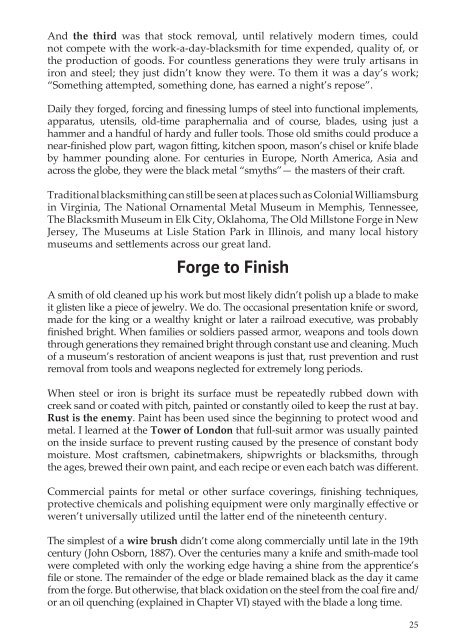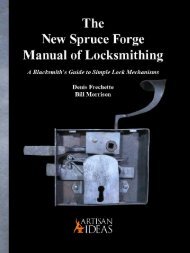FORGED: Making a Knife with Traditional Blacksmith Skills
This book will teach you to hand build a knife using the traditional method of blacksmiths of old — FORGING. Traditional forging of a knife blade is a process which uses the ancient techniques of moving hot steel with hammer and anvil alone into a knife-form that is ready for filing, heat treating and sharpening with no or very minimal electric grinding. This book also teaches traditional fit-and-finish skills using only hand tools. It explains an ancient riveted full-tang handle construction system that surpasses modern methods. In the author's words; "In my early blacksmithing years, I was lucky to get to know some old smiths who wrangled hot iron every day just to make a living. They unselfishly taught me traditional blacksmithing skills and knife forging methods. Every time I use those skills and methods, I honor their friendships, and by teaching you, the reader, we keep alive the memory of those old-time iron pounders." Hardcover, 132 pages, 150 photos and illustrations, $29.95.
This book will teach you to hand build a knife using the traditional method of blacksmiths of old — FORGING.
Traditional forging of a knife blade is a process which uses the ancient techniques of moving hot steel with hammer and anvil alone into a knife-form that is ready for filing, heat treating and sharpening with no or very minimal electric grinding.
This book also teaches traditional fit-and-finish skills using only hand tools. It explains an ancient riveted full-tang handle construction system that surpasses modern methods.
In the author's words; "In my early blacksmithing years, I was lucky to get to know some old smiths who wrangled hot iron every day just to make a living. They unselfishly taught me traditional blacksmithing skills and knife forging methods. Every time I use those skills and methods, I honor their friendships, and by teaching you, the reader, we keep alive the memory of those old-time iron pounders."
Hardcover, 132 pages, 150 photos and illustrations, $29.95.
You also want an ePaper? Increase the reach of your titles
YUMPU automatically turns print PDFs into web optimized ePapers that Google loves.
And the third was that stock removal, until relatively modern times, could<br />
not compete <strong>with</strong> the work-a-day-blacksmith for time expended, quality of, or<br />
the production of goods. For countless generations they were truly artisans in<br />
iron and steel; they just didn’t know they were. To them it was a day’s work;<br />
“Something attempted, something done, has earned a night’s repose”.<br />
Daily they forged, forcing and finessing lumps of steel into functional implements,<br />
apparatus, utensils, old-time paraphernalia and of course, blades, using just a<br />
hammer and a handful of hardy and fuller tools. Those old smiths could produce a<br />
near-finished plow part, wagon fitting, kitchen spoon, mason’s chisel or knife blade<br />
by hammer pounding alone. For centuries in Europe, North America, Asia and<br />
across the globe, they were the black metal “smyths”— the masters of their craft.<br />
<strong>Traditional</strong> blacksmithing can still be seen at places such as Colonial Williamsburg<br />
in Virginia, The National Ornamental Metal Museum in Memphis, Tennessee,<br />
The <strong>Blacksmith</strong> Museum in Elk City, Oklahoma, The Old Millstone Forge in New<br />
Jersey, The Museums at Lisle Station Park in Illinois, and many local history<br />
museums and settlements across our great land.<br />
Forge to Finish<br />
A smith of old cleaned up his work but most likely didn’t polish up a blade to make<br />
it glisten like a piece of jewelry. We do. The occasional presentation knife or sword,<br />
made for the king or a wealthy knight or later a railroad executive, was probably<br />
finished bright. When families or soldiers passed armor, weapons and tools down<br />
through generations they remained bright through constant use and cleaning. Much<br />
of a museum’s restoration of ancient weapons is just that, rust prevention and rust<br />
removal from tools and weapons neglected for extremely long periods.<br />
When steel or iron is bright its surface must be repeatedly rubbed down <strong>with</strong><br />
creek sand or coated <strong>with</strong> pitch, painted or constantly oiled to keep the rust at bay.<br />
Rust is the enemy. Paint has been used since the beginning to protect wood and<br />
metal. I learned at the Tower of London that full-suit armor was usually painted<br />
on the inside surface to prevent rusting caused by the presence of constant body<br />
moisture. Most craftsmen, cabinetmakers, shipwrights or blacksmiths, through<br />
the ages, brewed their own paint, and each recipe or even each batch was different.<br />
Commercial paints for metal or other surface coverings, finishing techniques,<br />
protective chemicals and polishing equipment were only marginally effective or<br />
weren’t universally utilized until the latter end of the nineteenth century.<br />
The simplest of a wire brush didn’t come along commercially until late in the 19th<br />
century (John Osborn, 1887). Over the centuries many a knife and smith-made tool<br />
were completed <strong>with</strong> only the working edge having a shine from the apprentice’s<br />
file or stone. The remainder of the edge or blade remained black as the day it came<br />
from the forge. But otherwise, that black oxidation on the steel from the coal fire and/<br />
or an oil quenching (explained in Chapter VI) stayed <strong>with</strong> the blade a long time.<br />
25










